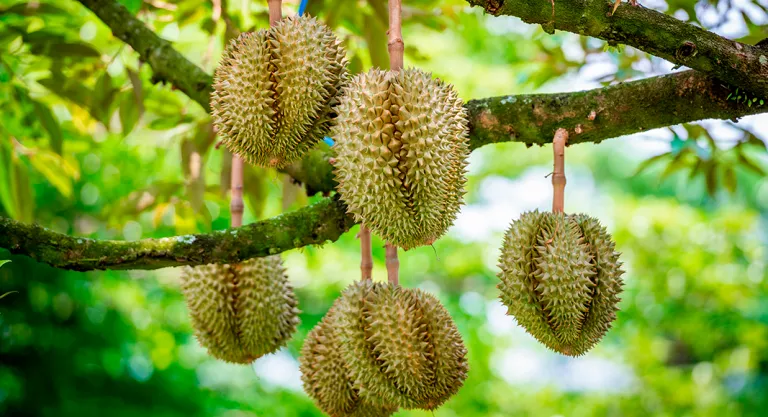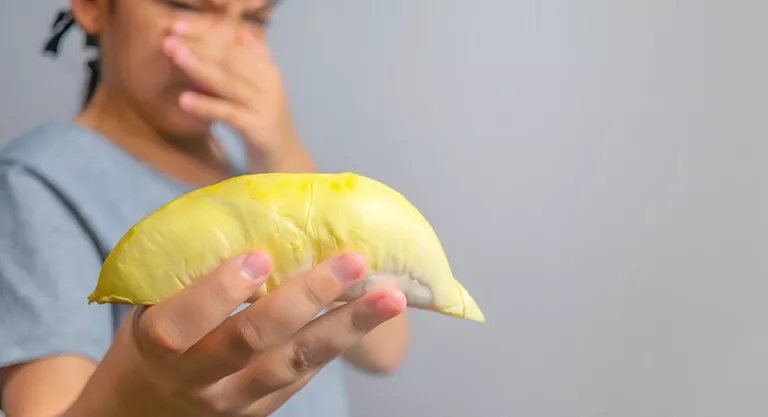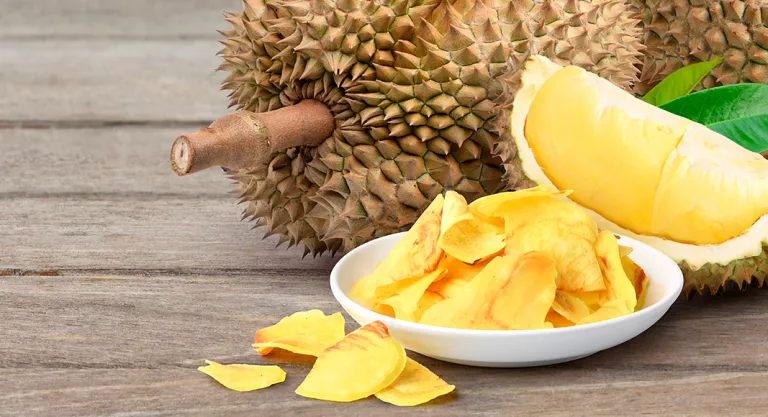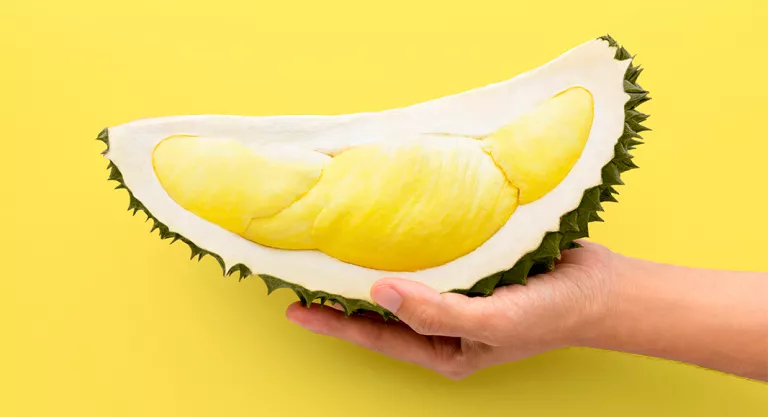
It seems like a contradiction, but the fact that something smells bad does not always mean that it tastes bad. An example of this is Roquefort or Cabrales cheese, which despite having a strong smell –similar to the smell of feet–, for many is a true delicacy. The same thing happens with the durian or durio, a typical fruit of Southeast Asia, where it is known as “the king of fruits”, which becomes so pestilential that it has been banned on public transport, some hotels and even markets in countries like Singapore or Malaysia, we will tell you all about it, from the virtues that it hides under its thorns and how it is taken… if you dare to try it.
This tropical fruit originates from Malaysia, Brunei and Indonesia, although its cultivation has later spread to other areas of Southeast Asia such as Thailand, its main exporter, or Singapore. It grows from the trees that bear the same name and precisely it comes from the Malay language, where ‘duri’ means ‘thorn’ and ‘an’ is the suffix that is added to the word to form an article in this language (“the thorny” ).

And it is that the durian is characterized –in addition to its stinky smell– by having a hard shell full of large spikes or thorns, which means that gloves are needed to open it, in addition, this fruit is a little oval and color between yellowish green and brownish green. As for its size, it usually measures about 30 cm long and 15 in diameter, and its weight range is between 2 and 5 kilos.
Why does durian smell so bad?
Its smell is so peculiar – many say excrement – that it has made the durian cataloged as the stinkiest fruit in the world. A group of German researchers published an article in the Journal of Agriculture and Food Chemistry in which they analyzed a durian with a mass spectrometer and a gas chromatograph. The results indicated that its stench is due to more than 50 complex chemical components, four of which were unknown to science. In addition, they discovered that it was not only the compounds that generated the bad smell, but that their own mixture was the trigger for everything.
The smell of durian has been described as a mixture of sulfur with hints of onion, garlic or honey.
The work describes the smell of durian as fruity, metallic, rubbery, burnt, garlic, cheese, onion and honey. Several of the substances found have been detected in some others before, such as cooked beef, yeast extract, dried squid and leeks.

Another study in the journal Nature Genetics revealed that the durian has approximately 46,000 genes, almost twice as many as humans. A special group of genes, called methionine-gamma-lyases, regulate the production of odorous compounds known as volatile sulfur compounds, this could explain why many people describe their smell as sulfurous. This research also indicated that the closest ancestor of this fruit is cocoa.
how to eat durian
The first thing you have to know is that durian is difficult to find in conventional greengrocers, unless they are in Asia. In addition, its price is also usually high, being able to cost between 5 and 10 euros per kilo. As a fruit can be around three kilos, you can be paying around 20 euros per piece.

To open the durian it is necessary to have gloves and a knife that is very sharp. The first thing to do is cut the stem and a small area of the upper part of the shell, then look for the internal joints of the fruit and cut them, you will only have to place your fingers on each side of the opening and pull the joints in opposite directions, the result will be wedges of creamy pulp.
Durian flesh is fleshy, with an avocado-like texture, and has a sweet, vanilla-like flavor.
Once it is open, we find the fleshy inner pulp like that of an avocado and which, depending on the variety, will be yellow, pink or orange. Within this peculiar fruit we can see between one and seven fairly large brown seeds that mean that only approximately 35% of the durian can be used for consumption. Some regions choose to also eat roasted, toasted or fried seeds.
The durian pulp is sweet, some say with hints of vanilla, which is why, despite its unpleasant smell, it is used to flavor ice cream, cakes, cookies or candies, among other products, but it is also very It is common to eat it fresh accompanied by rice, as is done in Thailand, for example. There are also varieties with a little bitter aftertaste.
Nutritional properties of durian
Nutritionally speaking, the durian is a fruit that provides a large amount of energy, approximately 100 g of its pulp is equivalent to 147 kcal (7% of the average daily amount), 5.33 g of fat, 0% sugar and 1.47 g of protein, according to data provided by Todoalimentos. In addition, it has a large amount of water, no less than 64.99 g out of 100.

As for vitamins, durian has large amounts of vitamin A (44 mg), vitamin B9 or folic acid (36 mg) and vitamin C (19.7 mg), and mineral amounts of potassium (436 mg ), phosphorus (39 mg) and magnesium (30 mg). Finally, the fat in this fruit amounts to 5.33 g per 100 g, which would be 8% of the recommended daily intake.
There is a superstition that taking durian with alcohol kills, this is because it inhibits the enzyme alcohol dehydrogenase, responsible for breaking down alcohol in the liver
With all these nutritional properties, Asians have used durian to regulate blood pressure, promote the production of white blood cells, strengthen bones and muscles, relieve migraines, combat insomnia and anemia, improve memory, as an anti-inflammatory, antibacterial, antifungal and as an aphrodisiac food.
An example of its antibacterial power is that bandages have recently been developed with powdered cellulose from the durian shell and glycerol that could help in wound healing, making them heal faster, and prevent infections, giving them a better prognosis. .

Another of the curiosities of the durian is that around it there is a superstition that it can cause death if you mix it with alcohol, and the truth is that this is not misguided, since it has been shown that some of the compounds that the fruit contains inhibit the enzyme alcohol dehydrogenase (ALDH) –responsible for breaking down alcohol in the liver–.
After everything you have read, you may have become curious about this exotic fruit and run to look for it, however, it is still difficult to find it outside of Asia. Even so, you can choose to see the reactions on the internet of those who have tried it, surely you would later rethink being even a meter from one of these fruits.
.